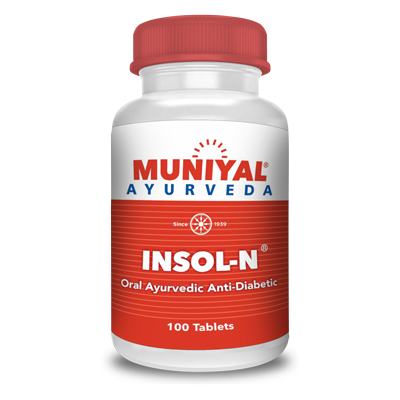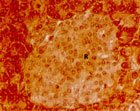
| Charges in INR |
Rs.380 |
| Add to Cart | |
Note: You will be directed to our eCommerce portal on click [muniyalayurveda.in]
INSOL-N Tablet
-
INSOL-N is the drug of choice in keeping the blood sugar at a normal level in ‘Non-insulin-dependent diabetes’.
-
Also found useful in ‘Insulin-dependent diabetes’, as it reduces the daily requirement of insulin dosage.
-
Does not cause hypoglycemia. It enhances the body resistance.
-
Reduces the chances of possible complications of diabetes like Diabetic Gangrene, Diabetic Neuropathy, Diabetic Retinopathy, and Vascular diseases like Atherosclerosis.
INSOL-N Tablet creates a new dimension in the treatment of DIABETES. Being a research product INSOL-N is a combination of more than forty anti-diabetic herbs, six ‘bhasmas’ and Shilajith. It keeps the blood sugar at a normal level and due to the presence of various bhasmas. It raises the body resistance which is usually lowered in diabetics which in turn makes them less susceptible to other infections. INSOL-N is absolutely safe and there is no risk of hypoglycemic coma.
Director of United States Patent and Trademark Office has granted US patent for Insol-N
Principal Ingredients:
• Jambu, Neem, Karavellaka, Methi, Madhunashini (Proven oral Hypoglycemics)
• Shilajith (Aphrodisiac, hypoglycemic, hypolipidemic)
• Amla (Rich natural source of Vitamin C, antioxidant, hypoglycemic)
• Turmeric (A known antiseptic, antioxidant and proven hypoglycemic & hypolipidemic)
• Abraka Bhasma (Natural Iron, hepatoprotective, immunomodulatory and nervine tonic)
DOSAGE: 2 Tablets Thrice Daily
INSOL-N does not contain any additives, not even to form the tablet (non-coated,non-capsulated)
IMPORTANT BENEFITS OF INSOL-N THERAPY
INSOL-N is the drug of choice in keeping the blood sugar at normal level in ‘Non insulin-dependent diabetes’ . Even in ‘Insulin-dependent diabetes’, INSOL-N is found useful as it reduces the daily requirement of insulin .
Above all, the chances of possible complications of diabetes like Diabetic Gangrene, Diabetic Neuropathy, Diabetic Retinopathy and Vascular disease such as Atherosclerosis will be significantly reduced by regular usage of INSOL-N.
SCIENTIFIC BACKGROUND
Diabetes Mellitus has been described in ancient ayurvedic texts under the name ‘Prameha’. They have also explained in-detail the etiology for the disease and various herbal remedies for the same. The ayurvedic seers were aware of the genetic susceptibility and environmental factors responsible for the disease.
According to the Modern Science, Diabetes Mellitus is a clinical syndrome characterised by hyperglycemia due to absolute or relative deficiency of Insulin. Lack of Insulin affects the metabolism of carbohydrate, protein, fat, water and electrolytes. If this state persists for long time, permanent and irreversible functional and structural changes in the cells of the body lead to the so-called complications of diabetes which affect the eye, the kidney and the nervous system.
Ayurveda, which advocates the holistic approach to the disease and advises the treatment in totality, plays an important role in controlling the blood sugar level at normal and preventing the complications of diabetes mellitus.
Insol-N, an ayurvedic medicine prepared by Muniyal Ayurvedic Research Centre, and tested on thousands of patients is one such medicine to treat Diabetes Mellitus, which has been clinically proved to rejuvenate the cells of Pancreas, hence helping the patient to live a healthy normal life.
INSOL-N has undergone intensive research work:
- A research work carried out at Manipal University has confirmed that Insol-N reduced HBA1 C level among diabetic patients by 40% within 3 months. Average blood sugar level is also reduced considerably. The study has established highly significant satisfactory level of patients, confirming that Insol-N tablets improve quality of life among diabetics.
- A post-graduate from Mangalore University in his research work induced diabetes or rats by injecting ‘Alloxan’ which destroys pancreas and subsequent administration of INSOL-N produced following results:
a) INSOL-N brings down the blood sugar to normal level within a short period.
b) Glycogen and protein levels in the tissues of the heart, liver and kidney are raised to normal level.
c) Lipid, cholesterol and tissue phosphates are brought down to normal level.
d) INSOL-N regenerates Beta cells of Islets of Langerhans of pancreas which secret body Insulin. The researcher got his M.Phil. for the above work. - Another post-graduate from Mangalore University has done Ph.D on INSOLI-N. An article was published in the souvenir released during the National Seminar on the role of indigenous drugs on diabetes mellitus held at Madras under the president ship of Dr. Sam G.P. Moses, Member, WHO Panel on Diabetes.
Although diabetes is a disease with a very ancient history and has been extensively studied, its safe and truly satisfactory treatment continues to elude us. The incidence is increasing even in hither to less affected areas like developing countries and rural populations, where the prohibitive cost of currently followed treatment cannot be sustained.. As part of community health planning strategy, the search for locality available low cost medicine is on. As mentioned earlier there exist many scattered reports of orally used hypoglycemic drugs, based on both laboratory and clinical observations, but follow up is inadequate.
SUMMARY OF EXPERIMENTAL STUDIES
- Experiment 1: Experimental diabetes was induced by alloxan in albino rats. Insol–N, an ayurvedic drug, was used therapeutically to control hyperglycemia in the diabetic animals. Alloxan treated diabetic rats were studied for the effect of Insol-N on biochemical and histological aspects.
- Experiment 2: Oral administration of Insol-N normalised the elevated blood glucose levels of the diabetic rats after two and four weeks of therapy.
- Experiment 3: Oral glucose tolerance test was carried out in normal, treated normals, diabetics and diabetics controlled by Insol-N (Experiment 1 and 2), to check blood Glucose homeostasis after the therapeutic regimen. The treated normals showed hypoglycemic effects, while the diabetic animals under drug therapy showed significant reduction in blood glucose levels

Figure: Oral Glucose Tolerance Test in Normal and Diabetic rats after Insol-N treatment.
- Experiment 4: Glycogen and protein depletion observed in the diabetic rat tissue were reversed by Insol-N therapy.


Figures: Tissue Protein and Glycogen of normal and diabetic rats afetr Insol-N treatment.
- Experiment 5: Enhanced lipid and cholesterol levels in the diabetic state was found to be markedly reduced after treatment.


Figures: Tissue Lipids & Cholesterol of normal and diabetic rats after Insol-N treatment.
- Experiment 6:Pancreatic amylase activities were below normal in diabetic animals. Administration of Insol-N could elevate the enzyme levels, but not to normal levels.
Enzyme |
Control |
Diabetic |
Diabetic under INSOL-N therapy |
|
AMYLASE (Milliunit/mg Protien) |
671.94 + – 7.46 |
*242.45 + – 10.41 |
*572.79 + – 15.35 |
Values given are mean + – SEM of seven animals in each group
*Variations are stastically significant at P<0.001
- Experiment 7: Enhanced levels of tissue phosphatase (acid and alkaline phosphatase ) and tissue transaminases (alanine and aspartate transaminases) in the diabetic tissues showed significant reduction after treatment.

Figures: Tissue Phosphatases in Insol-N treated rats.

Figures: Tissue Transaminases in Insol-N treated rats.
- Experiment 8: Histological studies made in pancreas of diabetic rats showed islet cell degranulation and destruction of B cells. Regeneration of B-cells and increased islet cell mass was noted in the pancreas of diabetic rats after Insol-N treatment.

Normal Rats

Under Treatment

After Treatment
Clinical Studies
Hypoglycaemic action of Insol-N
A study on 60 NIDDM patients in the age group of 30-60 years was carried out on OPD Basis to evaluate the effect of Insol-N in controlling blood sugar and urine sugar levels. Insol-N tablets were administered at a dose of 2 tablets thrice daily and a regular follow- up was done at the end of 2nd, 4th, 6th week, and thereafter at monthly intervals till 6 months.
Among the above patients, 26 patients were diagnosed for the first time and were not under any anti-diabetic medications. Of the remaining 34 patients, 24 cases were on Glibenclamide (10mg/day) and 10 cases on Phenformin (75 mg/day). Despite the above treatment their blood sugar was not under control.
All the other causes of hyperglycemia were ruled out and routine systemic examination and initial FBS & PPBS along with urine sugar were tested. Standard diabetic diet was prescribed to them and advised to continue their normal morning walk for 45 minutes.
Indications
- In Non-Insulin Dependant Diabetes Mellitus
- As an adjuvant in IDDM along with Insulin therapy.
- Diabetic neuropathy.
- Diabetic nephropathy.
Side Effects:
No major side-effects have been observed, even with prolonged treatment.
Dosage:
In NIDDM: Initially 2 tablets thrice daily followed by a maintenance of 2 tablet twice daily.
In IDDM: 2 tablets twice daily along with Insulin. When blood sugar comes to normal, the dosage should be increased to 2 tablets thrice daily, consequently trying to reduce Insulin dosage.
Presentation: In waterproof plastic container
Contents: 100 tablets
